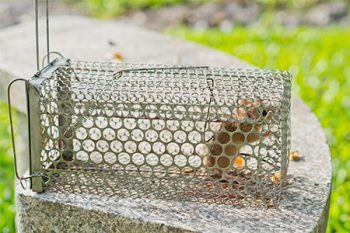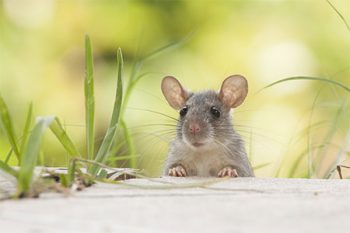Identifying Rodents in Your Home


Over time, urban areas containing fragmented food and harborage sites may contain hundreds and even thousands of mice depending on the local conditions. Indoor populations of mice have relatively short home ranges, with nests contracted in many different structural locations. The house mouse is unpredictable and erratic in its feeding behaviors, but tends to be an opportunist on most human foods.
Identifying the house mouse
| Length of adult body | 2.5-3.75in/65-95mm |
| Length of tail | 3.75in/95mm |
| Height of skull | 0.25in/6mm |
| Adult weight | .5-1.1oz/3.30g |
| Juvenile weight | 0.2-0.4oz/6-12g |
| Length of hind foot | 20mm |
| Toes on front foot | 4 |
| Toes on hind foot | 5 |
| Breeding life (females) | 6-10 litters |
| Litter size | 5-6 |
| Gestation period | 18-21 days |
| Age at weaning | 21 days |
| Age at mating | 6-10 weeks |
| Breeding season | All year inside buildings |
| Home range inside building varies | 6-30ft/2-10m |
| Lifespan | 1-2 years |
One female can have 60 offspring in her life. Before her life is over her offspring can have 270 offspring. That’s 330 offspring, from one mouse!
Rodent infestation
Nests and Nest Locations
A rodent’s nest provides a place for resting, birthing, rearing the young, grooming off dirt and ectoparasites, and for protection from the elements, predators, and other mice. A good nest and nest location is necessary for survival. The female mouse spends much time and energy collecting nesting materials and constructing nests. Nest- building activity in the female is especially pronounced just prior to her giving birth and prior to the onset of cold weather.
Because of its small size, the house mouse can nest in many different structural nooks and crannies inside buildings, as well as within many different types of stationary items and objects. In this regard, the mouse has an advantage over the larger rat. Mice have been discovered nesting within the shell of a hollowed-out hard roll inside of bakeries (after first consuming the bread).
Seasonal Rodents


Nests are also commonly established within the insulated walls of building or commercial coolers and freezers. If needed, the mouse will line the nest with materials that provide bedding and insulation from the cold using paper, cardboard, plastic, fabric, string, leaves, vegetation stems, and virtually any other material the mouse can readily find. Research has shown that pregnant female mouse may make as many as 150 or more errands to collect nesting material during the course of just one night.
Depending on the availability of space and nesting materials, nests may be elaborate in form, such as a globular ball that encompasses the mouse, or merely comprised of skimpy platform with a few pieces.
Permanent Rodent Control
When controlling mice, Anteater Exterminating, Inc. utilizes an integrated pest management approach. The environment, the sanitation, the harborage, and the access are all critical elements to control. Placement of traps or stations should be done in all areas of known activity. The rodent control devices must be placed correctly to be effective. Often control trap installation requires access so some appliances or storage items may need to be moved.
How to get rid of Rodents
2 T-Rex Tension traps inside Protecta Evo®
Tin Cat®
To be proactive, exterior rodent control systems can be installed. The stations or traps can be located in a manner that will prevent mice from ever infesting a property. All stations must be anchored, secured shut and maintained on a regular basis. Rodent control devices can consist of bait stations, tension traps, curiosity traps, glue boards, or a combination of them.
Catch Master® Glue Boards
Mechanical exclusion can also help prevent mice infestations. Mice can enter a home through any opening the size of a dime! The cracks or holes should be located and sealed with a sturdy material.
Rodent Control Near Me
When doing a rodent control intensive, the Anteater Exterminating, Inc. technician will install all needed rodent control devices and provide a plan to follow up as needed. The Anteater Exterminating, Inc. service technician can also provide you with a written proposal to address any needed mechanical exclusion work.
Frequently Asked Rodent Control Questions
1. Exclusion: Seal all entry points using materials like copper wool for small gaps and sturdy materials for larger openings. Focus on areas around pipes, vents, doors, and windows.
2. Sanitation: Keep your home clean and free of clutter both inside and outside. Store food in airtight containers, including pet food, and regularly dispose of garbage in tightly sealed bins.
3. Elimination: Use traps strategically placed along rodent pathways. Snap traps are effective for capturing mice quickly, while humane traps can be used for relocation.
4. Professional Extermination: Seek help from local pest control experts who can conduct thorough inspections, use specialized treatments, and provide ongoing monitoring to ensure the infestation is completely eradicated.
Combining these methods ensures a comprehensive approach to rodent control, addressing both current infestations and preventing future ones.
1. Identify Entry Points: Seal all possible entry points into your home using materials that rodents cannot chew through, such as copper wool or steel mesh.
2. Set Traps: Place snap traps baited with peanut butter or other attractants along walls and in areas where rodents are active. Check traps daily and reset as needed.
3. Remove Food Sources: Store food in airtight containers, clean up spills promptly, and secure garbage in tightly sealed bins to eliminate food attractants.
4. Sanitize: Clean areas where rodents have been active to remove traces of urine, feces, and nesting materials, as these can attract more rodents.
5. Seek Professional Help: If the infestation persists or is severe, contact a professional pest control service for effective and safe extermination methods.
Acting swiftly and systematically will help ensure rodents are removed from your home as quickly as possible.
Hantavirus: Spread through contact with rodent urine, feces, or saliva, causing flu-like symptoms that can progress to severe respiratory problems.
Leptospirosis: Contracted from exposure to water or soil contaminated with rodent urine, leading to symptoms such as fever, headache, muscle aches, and potentially liver or kidney damage.
Salmonella: Caused by consuming food or water contaminated with rodent feces, leading to gastrointestinal symptoms like diarrhea, nausea, vomiting, and abdominal pain.
Lymphocytic Choriomeningitis (LCM): Transmitted through contact with rodent urine, droppings, saliva, or nesting materials, causing flu-like symptoms and potentially severe neurological complications.
Plague: Though rare, rodents can carry fleas that transmit plague bacteria to humans, causing symptoms such as fever, chills, headache, and swollen lymph nodes.
To prevent these health risks, it’s crucial to address rodent infestations promptly with effective control measures and, if necessary, seek professional assistance for thorough extermination and cleanup.
